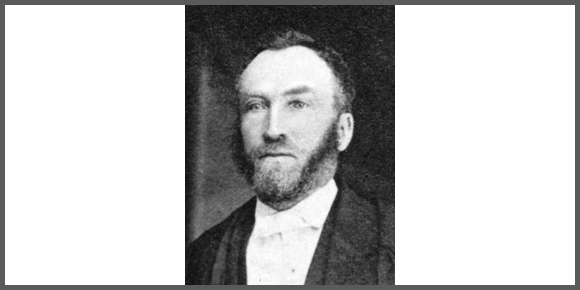by Bruce Cherney
Thomas Spence was a man whose pursuit of the “big idea” would bring him notoriety rather than the fame he cherished. His attempts at seizing the reins of power bordered on the side of comic opera, especially in Portage la Prairie where he created the short-lived Republican Monarchy of Manitobah.
John Harrison O’Donnell, a physician from Ontario who came to the Red River Settlement in November 1869, described Spence as having “quite a few of the characteristics of Wilkins Micawber (a character in the Charles Dickens novel David Copperfield), he was always living in great expectations, and when they were not materializing he became depressed, and would tell dramatically how shamefully his services had been overlooked by the federal government.
“It was never apparent what these services consisted of, but it was an excellent text for considerable eloquence on his part, mingled with an occasional tear; but a friendly suggestion of a ‘yard of clay’ and a little of the cup ‘that cheers,’ and he felt sure that his great services would be duly considered by the government.”
Spence was considered a likeable fellow, much as David Copperfield regarded Micawber. Micawber rose from debtors’ prison to the lofty station of magistrate in the colonies. When he was to make his departure to Australia after suffering many tribulations in England, Mrs. Micawber told Copperfield that she wanted her husband to stand on the brow of the ship and declare his intent, “This country I come to conquer.”
Judging by Spence’s early career in Manitoba, it isn’t too difficult to imagine him duplicating Micawber’s declaration and thus announcing his intent to conquer his own new land.
Spence came from Scotland in 1852 and took up residence in Canada (then comprising only portions of modern-day Quebec and Ontario). Although he would eventually rise to fame in Manitoba, when he came to the Red River Settlement in 1866, he started out as a simple handyman.
Upon his arrival, he made it be known that he had been a military officer in a Foot Regiment, a land surveyor and a practitioner of the legal profession. Mrs. Micawber had likewise told Copperfield that her husband told all within hearing distance that he had been an officer in the British Marines, but she wasn’t able to determine if he had gained the status of officer, but was sure he had been a marine. No one quite knew if Spence had been telling them the truth or inventing a new persona for the New World. What is known for certain is that his latter trades can properly be described as author and clerk of the Manitoba Legislature.
His first foray into controversy came on December 8, 1866, when Spence organized a meeting in the Fort Garry Courthouse to secure support for the transference of the settlement into thefold of British North Americas. At the time, the settlement and all the lands of Rupert’s Land were in the possession of the Hudson’s Bay Company.
The meeting was set for 10:30 a.m., but apparently Spence and four of his supporters arrived an hour early and passed the confederation resolutions and then gave three mighty cheers to Her Most Gracious Majesty The Queen.
They then left the courthouse and encountered “Dutch George” Emmerling, a hotel owner who advocated annexation of the settlement to the United States. A discussion ensued which was continued in the courthouse. At the instigation of Emmerling, the resolutions were declared null and void.
A heated argument broke out among those attending and any proposed motions were quickly opposed. Robert Hill, a resident of Portage la Prairie in the 1870s, and author of Early Days in Manitoba, related that “after some time, the entire crowd sought a hasty and uproarious exit from the doors, some imagined with a view to continuing hostilities on a more extended scale outside, but the cooling influences of the December wind led them to seek shelter in Mr. Emmerling’s, where an orgy was instituted which ended about midnight in the demolition of his bar and general destruction of his bottles and earthenware, not to speak of the damage done to his fluids.”
This outbreak was to be the harbinger of what occurred when Spence attempted to create another government on the Canadian prairie.
Hill’s account of the events of Spence’s early career are the most complete and it can be presumed that he had access to first-hand witnesses. His book, relating to the Spence years in Portage, was published in 1890. Given its comical retelling of the events, the book may contain a bit of the blarney. Still, it’s a good read.
Not deterred by his first unsuccessful entry into the political arena, Spence pulled up stakes and made his way west to Portage la Prairie in 1867 where he opened a store.
The community, which then numbered about 400 people, was outside the jurisdiction of the Council of Assiniboia, the HBC’s governing body for the Red River Settlement. Spence took this as a good omen since the lack of government meant that the local citizens could establish their own ruling elite with him at the top. The fact that eluded Spence was that the region was still under HBC jurisdiction as part of its 1670 company charter granted by King Charles II.
Hill said it didn’t take Spence “long in inaugurating himself as one of the leading factional spirits of the settlement.”
It came to be that Spence had himself appointed president of the new Republican Monarchy of Caledonia with Findlay Ray as his secretary. Caledonia must have been too unpopular because Spence had it shortly changed to the republic Monarchy of Manitobah. But to his credit, Spence was the first to conceive of using the Cree name, derived from a legend about the narrows of Lake Manitoba, as an official name to describe the land he sought to govern.
(Next week: part 2)



